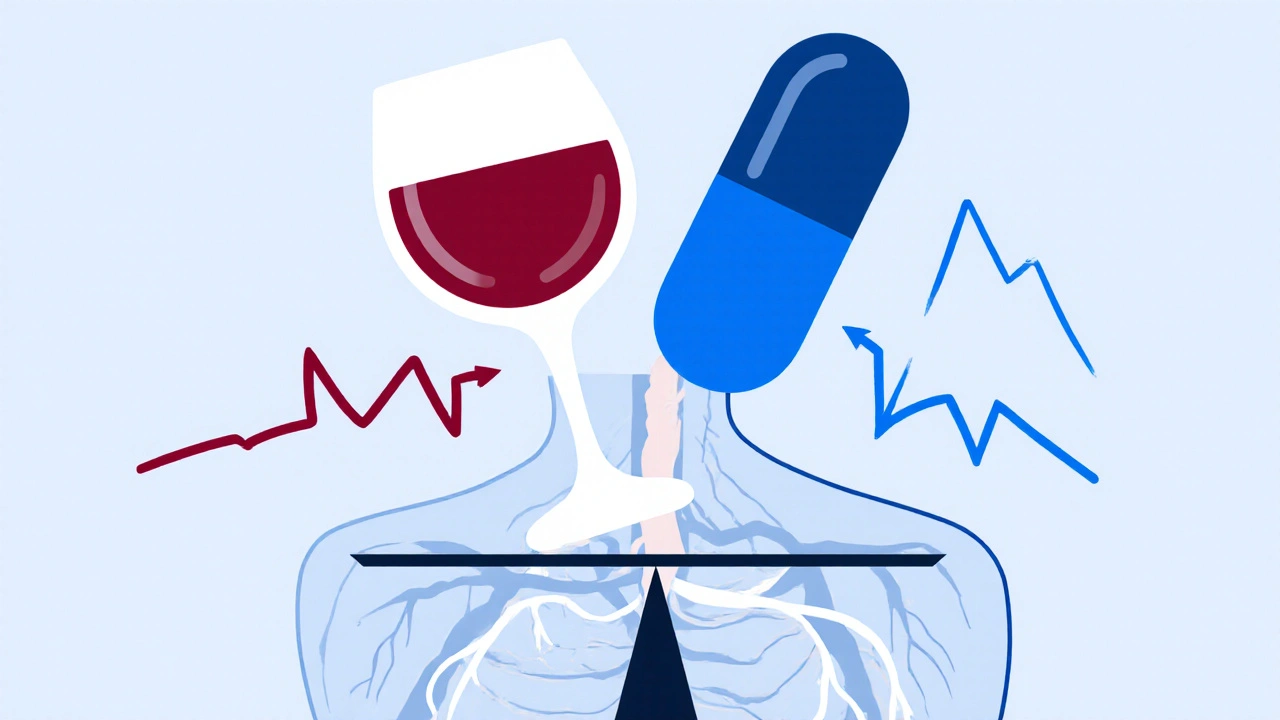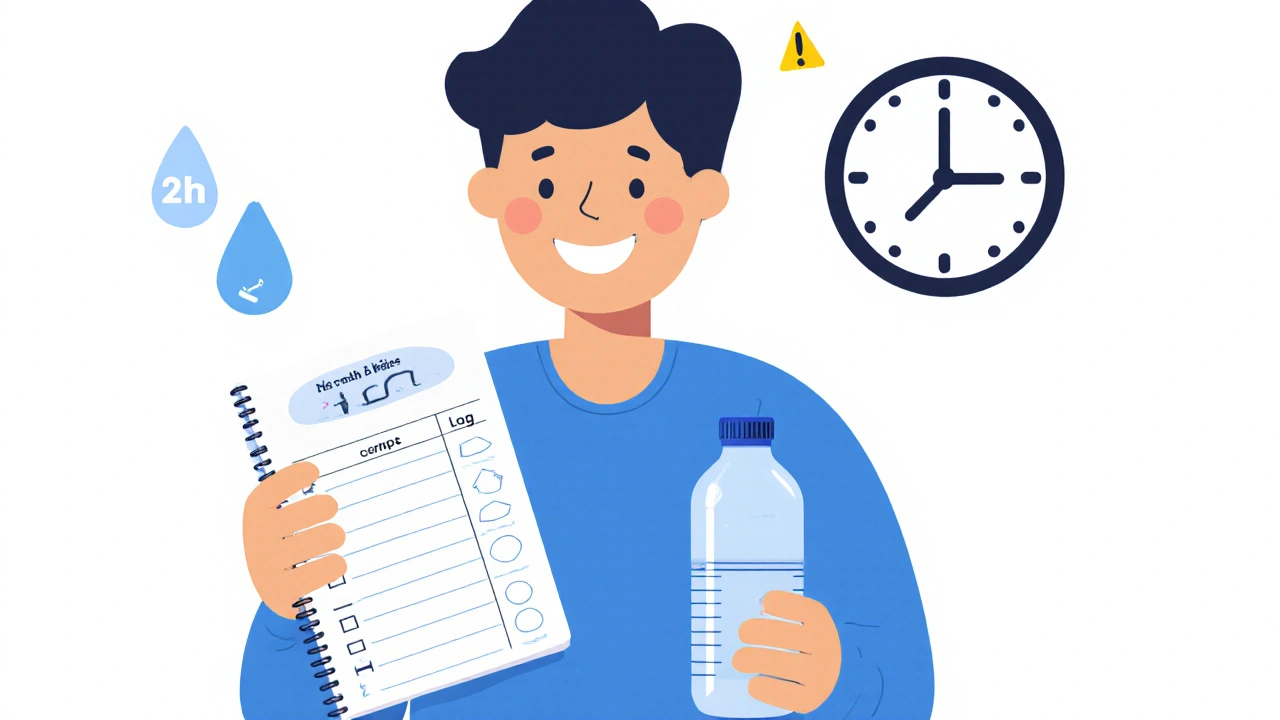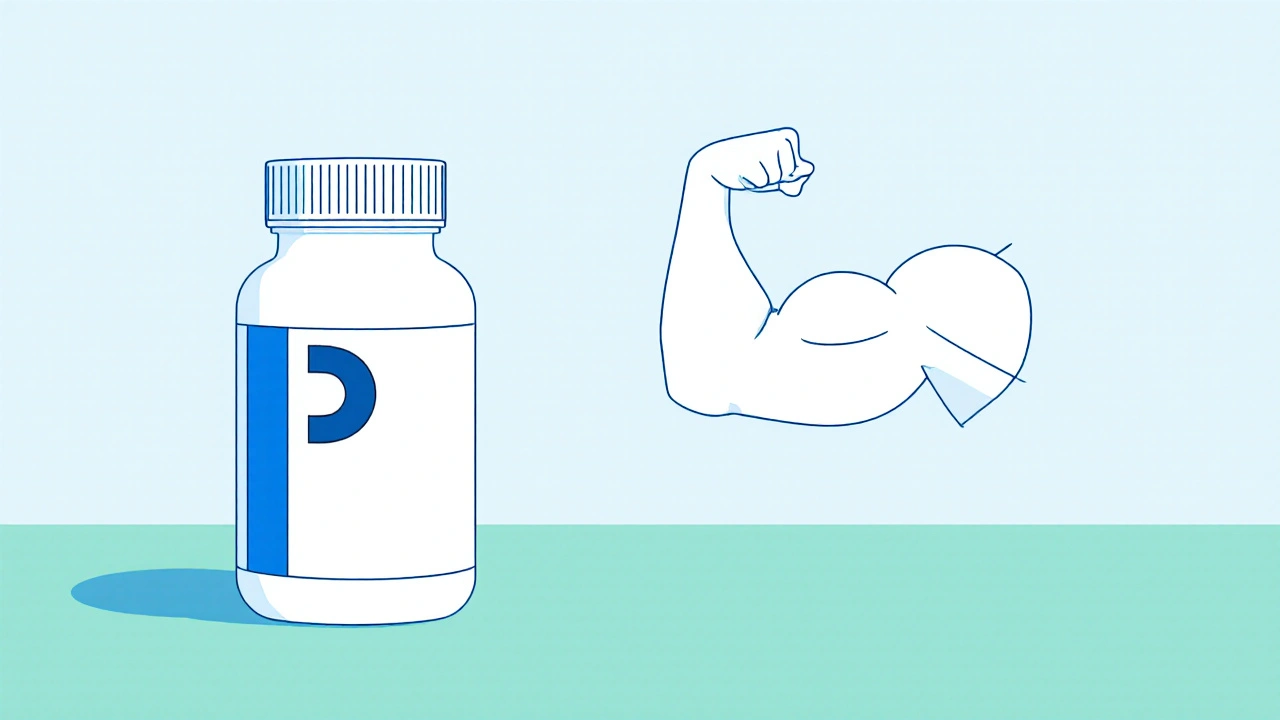Pyridostigmine Alcohol Interaction Risk Calculator
Calculate Your Risk Level
Your Risk Assessment
Important Safety Tips
Based on your inputs, here are key safety considerations:
- Monitor for symptoms - Watch for increased sweating, muscle cramps, or difficulty breathing
- Stay hydrated - Drink water between alcoholic beverages
- Never exceed 1 drink - Higher amounts significantly increase risk
- Wait at least 2 hours - After taking pyridostigmine before drinking
Warning: If you experience any severe symptoms (shortness of breath, rapid muscle weakness), seek emergency medical help immediately.
When you take Pyridostigmine bromide is a reversible acetylcholinesterase inhibitor prescribed mainly for myasthenia gravis, you might wonder whether having a drink is okay. The short answer isn’t a simple yes or no - it depends on how the drug works, how alcohol affects your body, and what you’re trying to avoid.
What Is Pyridostigmine Bromide?
Pyridostigmine bromide is a short‑acting cholinesterase inhibitor that boosts the level of acetylcholine at the neuromuscular junction. By preventing acetylcholine breakdown, it helps muscles contract more strongly, which is why it’s the go‑to medication for people with myasthenia gravis an autoimmune disease that weakens skeletal muscles. Typical doses range from 60 mg to 180 mg per day, split into several doses to keep symptoms steady.
Common side effects include stomach cramps, increased saliva, and muscle twitching. Rare but serious issues involve a cholinergic crisis a dangerous buildup of acetylcholine that can cause difficulty breathing and severe muscle weakness. Knowing these basics helps you understand why mixing anything - especially alcohol - could tip the balance.
How Alcohol Affects the Body
Alcohol is a central nervous system depressor. It slows brain activity, reduces coordination, and lowers the body’s ability to regulate temperature. After you drink, the liver works hard to break down ethanol using enzymes like CYP2E1 a member of the cytochrome P450 family that metabolizes alcohol and other pathways.
Blood Alcohol Concentration (BAC) is the standard measure of intoxication. A BAC of 0.08% (the legal limit in many countries) typically impairs judgment and reaction time. Higher levels can cause vomiting, loss of consciousness, and even respiratory depression.
The Pharmacological Intersection
Both pyridostigmine bromide and alcohol influence the nervous system, but in opposite directions. Pyridostigmine raises acetylcholine, making muscles more excitable, while alcohol suppresses nerve signaling. When combined, you risk a mismatch that can lead to two main problems:
- Excessive cholinergic activity - Alcohol can aggravate the side effects of pyridostigmine (e.g., cramping, sweating) by altering how the drug is absorbed and cleared.
- Respiratory depression - If a cholinergic crisis occurs, the added depressant effect of alcohol can make breathing problems worse.
Research from the Journal of Neurology (2023) showed that patients who consumed more than two standard drinks per day while on pyridostigmine had a 1.8‑fold increase in reported muscle weakness episodes. The study also noted that liver enzyme levels (AST/ALT) rose modestly, indicating that alcohol can interfere with the drug’s metabolism.

Key Interaction Effects
| Effect | Typical Outcome | Risk Level |
|---|---|---|
| Increased gastrointestinal cramps | More frequent stomach pain, nausea | Moderate |
| Enhanced sweating & salivation | Visible drooling, clammy skin | Low‑to‑moderate |
| Potential cholinergic crisis | Severe muscle weakness, breathing difficulty | High (especially with >3 drinks) |
| Reduced drug clearance | Higher plasma pyridostigmine levels for longer | Moderate |
| Impaired judgment | Forgotten doses, accidental overdose | Low‑to‑moderate |
Practical Safety Tips
- Know Your Dose - Keep a written log of how much pyridostigmine you take each day. If you miss a dose, follow your doctor’s guidance before thinking about a drink.
- Limit Alcohol - For most patients, a single standard drink (12 oz beer, 5 oz wine, or 1.5 oz spirits) is the upper safe limit. Anything beyond that spikes the interaction risk.
- Stay Hydrated - Alcohol can dehydrate you, worsening muscle cramps. Drink water between alcoholic beverages.
- Watch for Warning Signs - Sudden increase in muscle weakness, excessive sweating, or difficulty breathing means you need medical help right away.
- Timing Matters - If you plan to consume alcohol, do it at least 2 hours after your pyridostigmine dose. This gives the drug time to distribute and lowers peak concentration overlap.
- Consult Your Physician - Everyone’s metabolism differs. Your doctor may adjust the pyridostigmine dose or suggest an alternative if you regularly drink.

What To Do If You Accidentally Mix Them
First, stay calm. Most mild symptoms (like extra sweating) resolve on their own with rest and hydration. However, if you notice any of the following, act fast:
- Rapid onset of severe muscle weakness or double vision
- Difficulty speaking or swallowing
- Shortness of breath or feeling like you can’t catch your breath
- Chest tightness or irregular heartbeat
Call emergency services and mention that you’re on pyridostigmine bromide. Paramedics may administer atropine an anticholinergic drug that counters cholinergic crisis if a crisis is suspected.
Bottom Line
Mixing pyridostigmine bromide with alcohol isn’t outright forbidden, but it carries measurable risks. By keeping drinks to a minimum, timing your intake wisely, and staying alert for warning signs, you can protect yourself from serious complications. If you’re ever unsure, the safest move is to skip the alcohol until you’ve talked with your healthcare provider.
pyridostigmine bromide alcohol safety
Can I have a single glass of wine while taking pyridostigmine?
Most doctors say one standard drink is okay for most patients, but you should still monitor for extra sweating or cramps. If you have a history of cholinergic crises, it’s best to avoid alcohol altogether.
Does alcohol change the effectiveness of pyridostigmine?
Alcohol can slow the liver’s ability to clear pyridostigmine, leading to higher blood levels for longer. This might improve muscle strength temporarily but raises the chance of side effects.
What are the signs of a cholinergic crisis?
Look for rapid muscle weakness, drooping eyelids, difficulty breathing, and excessive salivation. If any of these appear, seek emergency care immediately.
Should I adjust my pyridostigmine dose if I plan to drink?
Never change the dose on your own. Talk to your physician-they may suggest a temporary adjustment or advise you to skip alcohol for a few days.
Is it safe to take pyridostigmine with other depressants, like benzodiazepines?
Combining multiple depressants can increase the risk of respiratory problems. Always discuss any additional meds or supplements with your healthcare team.

Ron Lanham
Let me be perfectly clear: the reckless mixing of pyridostigmine bromide with alcohol is not a trivial matter that can be dismissed with a casual shrug. The drug in question works by elevating acetylcholine levels, and any external agent that tampers with the nervous system balance must be treated with the utmost caution. Alcohol, a central nervous system depressant, can mask the early signs of cholinergic excess, leading patients to unknowingly drift into a crisis. When you ingest alcohol, you also burden the liver, the very organ responsible for metabolizing pyridostigmine, thereby prolonging its activity and amplifying side effects. This metabolic interference is documented in recent clinical observations, which show a near‑doubling of muscle weakness episodes among drinkers on the medication. Moreover, the combination can precipitate excessive sweating and salivation, symptoms that may seem benign but are harbingers of a deeper imbalance. The risk does not end at mild discomfort; a full‑blown cholinergic crisis can manifest as severe respiratory distress, an outcome that no one should gamble with. It is morally irresponsible to downplay these dangers for the sake of a fleeting buzz. Patients must adhere to the recommended limit of a single standard drink, and even that should be spaced at least two hours after a pyridostigmine dose. Timing is not a suggestion but a safeguard that respects the pharmacokinetics of the drug. Hydration, often overlooked, plays a critical role in mitigating gastrointestinal cramps that can be aggravated by alcohol. Ignoring the advice to stay hydrated is tantamount to self‑sabotage. Physicians have repeatedly emphasized that any deviation from prescribed guidelines necessitates a conversation with a healthcare professional. Skipping that conversation is an act of negligence that can endanger not only the individual but also burden emergency services. The bottom line is simple: treat this interaction with the seriousness it deserves, or face consequences that could have been avoided. In my view, the only responsible choice for anyone on pyridostigmine who enjoys a drink is to limit consumption dramatically and monitor bodily signals obsessively.
Deja Scott
One drink can be okay if you stay within the limits.
Natalie Morgan
The guidelines suggest a single standard drink is the upper safe boundary but the key is timing. Waiting at least two hours after your pyridostigmine dose lets the drug distribute before alcohol hits the system. This reduces peak overlap and makes metabolism easier. Also keep water handy to counteract dehydration that can worsen cramps.
Mahesh Upadhyay
Yo, imagine mixing that muscle‑boosting pill with booze and thinking you’re invincible – pure drama! You end up fighting your own body, not the bar.
Rajesh Myadam
I hear you, Mahesh, and it’s tough when the party vibe clashes with health needs. It helps to plan ahead, maybe enjoy a non‑alcoholic mocktail instead. Your muscles will thank you and you’ll still have a good time.
Andrew Hernandez
Keep a written log of doses and drinks to stay on top of the interaction.
Alex Pegg
Logs are for the weak; real users live in the moment.
laura wood
Sharing experiences can be a lifeline for others navigating this medication. If you’ve found a strategy that works, speak up. Community wisdom often fills gaps left by clinical guidelines.
Kate McKay
Absolutely, Laura. It’s important to remember that every body reacts differently, so a cautious approach is wise. Try alternating alcoholic drinks with water-this not only keeps you hydrated but also slows down consumption. If you ever notice unusual muscle twitching or excessive sweating, pause and assess how you feel before reaching for another drink. And never underestimate the power of a good night’s sleep; recovery can mitigate many side effects. Stay safe and keep supporting each other.
Demetri Huyler
Honestly, the casual chatter here downplays a serious pharmacological conflict. If you truly care about your health, you’ll treat the interaction with the gravitas it deserves and probably skip the alcohol altogether.